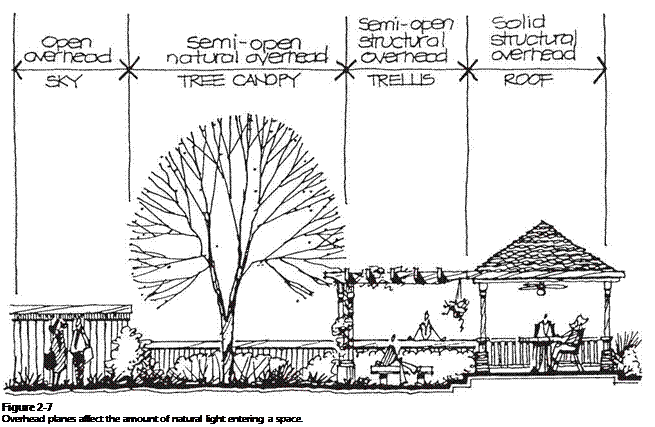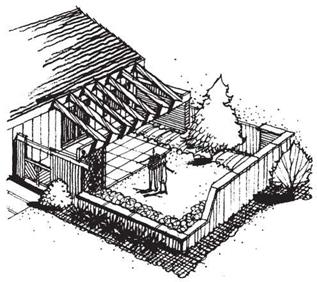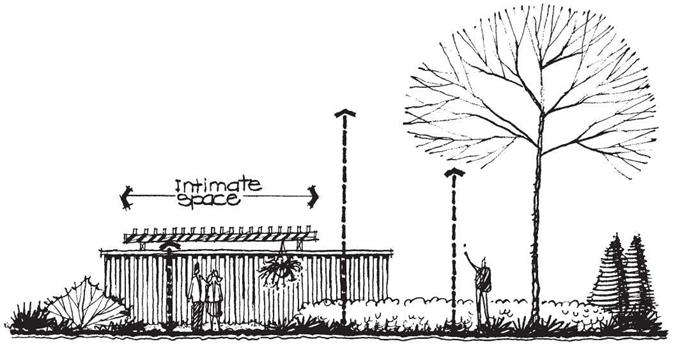Overhead planes are created by canvas awnings, overhead trellises, arbors, pergolas, the bottom of tree canopies, or even the clouds in the sky. Overhead planes have two functions. The first is to influence the amount and quality of skylight (including sunlight) that enters into a space (Figure 2—7). Overhead planes may be completely open where maximum skylight is desired or completely solid where little or no light is needed. In between these two extremes, overhead planes may be composed of various semitransparent and translucent materials that permit filtered and diffused light to enter into an outdoor space. Very dramatic light effects can be created by an overhead arbor (with or without vines), open trees such as a honey locust or palo verde, or light-colored canvas awnings. In a similar manner, a semitransparent or partially open overhead plane can cast attractive shadow patterns on the ground, adjacent walls, or fence (Figure 2—8). The second function of the overhead plane is to influence the perceived scale of a space. For instance, a low overhead plane is apt to create an intimate feeling, whereas a high overhead plane may establish a more uplifting or lofty setting (Figure 2-9).
In the outdoor environment, the base, vertical, and overhead planes function together to create a variety of spaces with different uses and feelings. For instance, an outdoor space may be almost completely enclosed to create a rather intimate and inward sensation (Figure 2-10). Such a space tends to have a strong sense of privacy and separation from other spaces. In contrast, an outdoor space may be quite open to provide an expansive feeling, outward-oriented views in many directions, and exposure to climatic elements such as sun and wind (Figure 2-11). Ultimately, the designer must decide what type and degree of enclosure is most suitable for an outdoor space to achieve the intended use and mood.
In some ways outdoor space is similar to indoor space. Both are volumes defined by the base plane, vertical planes, and overhead plane. People also live, work, and play
 |
 |
in both indoor and outdoor spaces, but there are differences that should be recognized and appreciated as well. Generally, when a person is indoors, there is little question as to where one room ends and another begins. The walls separating one room from another are typically solid and fixed in place with doors or other openings being the only spatial connection between them. Another characteristic of interior space is that its sense of enclosure and light does not vary much over a period of time, especially if windows are small or lacking.
![]()
|
|
|

By comparison, the edges of outdoor spaces are not as rigidly defined. Consequently, it is sometimes difficult to perceive where one outdoor space ends and another begins. Outdoor spaces often tend to be defined more by implication than by obvious enclosures (Figure 2—12). Plant materials, for example, don’t usually provide the sharp, clear edge that the walls inside a house do unless they are pruned to form precise hedges. Many plants have a fairly open character and are amorphous in shape, thus allowing views to extend to spaces and objects beyond. In addition, the elements that define outdoor space are often arranged in an informal manner, unlike the typical straight walls in a house.

Outdoor spaces change more dramatically over a period of time in comparison to their interior counterparts. Growth and seasonal variations have a tremendous influence on the space-defining abilities of plant materials. In some locations of the country, a space defined essentially by plant materials may seem very enclosed during the summer but quite open during the winter when leaves drop off. Perception of outdoor space is also influenced by variations in weather (sun, clouds, fog, rain, snow)
and light. An outdoor space may seem very appealing on a warm, sunny day yet uninviting and dismal on another day. Spaces tend to feel smaller and more enclosed during the evening than during the day because of reduced viewing distance in the dark. All the possible combinations of factors make the perception of outdoor space highly variable.




